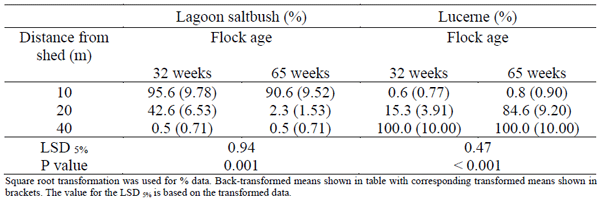I. INTRODUCTION
Maintaining vegetation on free range farms with fixed ranges is a significant issue (Singh et al., 2017). Nonetheless, free range accreditation programs stipulate palatable vegetation to be available on the range at all times (RSPCA 2015). This is more problematic to achieve during dry seasonal conditions and drought, which are common features of the Australian climate.
II. METHOD
The plant ground cover of a free range farm located in the temperate (Mediterranean) climatic zone of Australia was studied during the drought year of 2018. The long-term average annual rainfall for the area is 470 mm (winter dominant rainfall pattern); however, during 2018, the locality received only 250 mm. Lucerne (Medicago sativa) is the main plant sown on the ranges of the farm. The shed (15 x 50 m) and range area (3.8 ha) of the case study flock was established in 2014 and had four previous flocks. Subdivided range areas allow for rotation and resting of pasture every 12 months. Flock size was 5000 Hy-line Brown hens (infra-red beak treated at hatchery) stocked at 1500/ha. Pasture measurements of percentage green ground cover (visual score 0 to 100%), pasture height (cm) and botanical composition (dry weight rank method converted to percentage, Mannetje and Haydock 1963) were made at 10 m, 20 m and 40 m from the shed along four transects (2 transects each side of shed). At each distance (10, 20 and 40 m), 10 quadrats (50 x 50 cm) were assessed. Hens were 32 and 65 weeks of age at the time of pasture measurements (May 2018 and December 2018, respectively). Square root transformation was used for percentage data and Log10 for pasture height data. Results were analysed using ANOVA with flock age and distance from the shed as main factors and the interaction flock age x distance.
III. RESULTS
Distance from the shed significantly affected all variates measured (Table 1) . Ground cover at 10 and 20 m was similar and increased significantly at 40 m. Pasture height was taller moving further away from the shed. Lagoon saltbush was most commonly found closest to the shed, whereas the opposite was shown for lucerne. Weeds (mostly wire weed – Polygonum aviculare) grew predominantly at 10 and 20 m from the shed. Age of flock also significantly affected all variates (Table 2). Percentage ground cover, pasture height and percentage lagoon saltbush had all reduced when the flock was 65 weeks old. The reverse occurred for percentage lucerne and weeds, with proportionally more lucerne and weeds at flock age 65 weeks.
Table 1 – Main factor effect of distance from the shed (10, 20 and 40 m) on % ground cover, pasture height, % lagoon saltbush, % Lucerne and % weeds on an egg farm in southern Australia during 2018.
Table 2 – Main factor effect of flock age (32 weeks = May 2018 and 65 weeks = December 2018) on % ground cover, pasture height, % lagoon saltbush, % lucerne and % weeds on an egg farm in southern Australia during 2018.
The only interactions of flock age x distance were for percentage lagoon saltbush and lucerne (Table 3). When the flock age was 32 weeks, lagoon saltbush was common at 20 m. By flock age 65 weeks, the proportion of lagoon saltbush at 20 m had significantly reduced. Conversely, the proportion of lucerne had increased at 20 m. Lucerne remained dominant at 40 m from the shed at both flock ages. The range area reported in this paper will be examined during a second year (rest phase in 2019) and the range area rested in 2018 will be assessed with the new flock during 2019.
Table 3 – Interaction effect of flock age x distance from the shed on % lagoon saltbush and % lucerne on an egg farm in southern Australia during 2018.
IV. CONCLUSION
Hen activity at 1500 hens/ha resulted in plant species variations, ground cover decreases and pasture height reduction across the range. Green ground cover was not extensive during the drought with lucerne and lagoon saltbush providing the majority of green cover. Hens had to travel further for green pick as early summer progressed, with lucerne still available at 40 m. Under drought conditions, the provision of green palatable vegetation available on the range at all times would be difficult to maintain at high levels of ground coverage.
ACKNOWLEDGEMENT: Thank you to Australian Eggs for funding this research.
Abstract presented at the 30th Annual Australian Poultry Science Symposium 2020. For information on the next edition, click here. 











.jpg&w=3840&q=75)